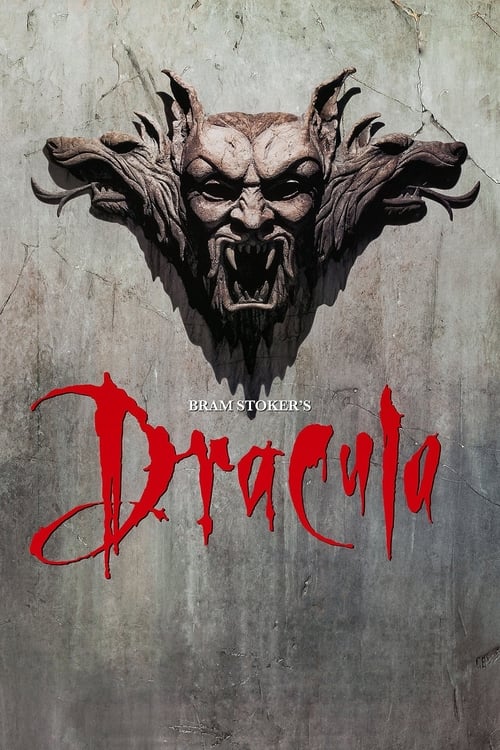Francis Ford Coppola’s Bram Stoker’s Dracula is a high-budget Hollywood movie with the marketing campaign to match. Even the 1931 Universal Dracula with Bela Lugosi was a budget affair. Coppola’s earned four Oscar nominations and won for costume design, sound effects editing, and makeup. (It was edged out on art direction by Howard’s End.)

I will never complain about wearing neckties again.
Coppola leans heavily into the fantastic nature of the story with dramatic sets and outsized matte paintings. Dracula’s eyes appear in the clouds, and his coachman apparently shops at the same mall as Sauron. A train rolls over a bridge that is a page of a diary. Vampire brides emerge from mattresses to feed on Harker’s blood. There are echoes here from 1931, but the fantasy landscapes, nonsensical architecture, and deep, shadowed, under-exposed shots seem more inspired by the 1989 Batman than Todd Browning’s vast open sets and outsized matte backdrops. Which is fair; bats figure heavily in both.
In earlier films, the real horror of the Count’s intrusion into human lives is his ability to usurp the authority of a father over a daughter, a brother over a sister, a husband over a wife. In these adaptations, the weak-willed women are victims of Dracula’s demonic influence. They must be restrained and overwhelmed by masculine medicine and civilized order. When that fails, their lustful bodies must be mutilated to return their souls to the chaste embrace of the patriarchal church.

I am not entirely certain whether this is a parlor or a greenhouse.
Coppola attempts to flip the script by creating an origin story for Vlad Dracula. In this, Vlad leaves his wife Elisabeth to do battle with the Turks. Vlad’s beautiful wife Elisabeta commits suicide, convinced he has fallen in battle. Vlad returns victorious, only to find Elisabeta dead. He renounces God, desecrates the sanctuary where she is lying in state, and in so doing is cursed with vampirism.
If you squint, you can recognize this as the final act of Romeo and Juliet. The bulk of the movie is about Vlad trying to reunite with Elisabeta, now reborn as romance-starved Mina (both Wynona Ryder). She is betrothed to the distressingly practical Harker, who she thinks she loves until Dracula arrives to sweep her off her feet. This is a love that cannot be. She is already promised, and he s is a demonic undead man-bat-wolf-rat-thing that has murdered her best friend. From Mina’s perspective, this is a story of her increasing awareness that she does not want to marry the approved boyfriend. Instead, she wants the dangerous man who makes her hot.

Count DGAF if it’s daytime.
Ryder, who also gave the script to Coppola, said this is what makes the film interesting. “It’s a very emotional love story…Mina, like many women in the late 1800s, has a lot of repressed sexuality.” That may be so, but as a feminist, sexual-liberation take on Dracula, the movie leaves a lot to be desired. There is very little to distinguish Vlad’s romantic interest from the passel of love-struck Romeos circling Lucy. And Mina is explicitly jealous of the attention Lucy gets. As a tale of female sexual liberation, 1974’s Vampira hits marginally closer to the mark even if it is an advertisement for Playboy. This script more closely resembles the late twentieth-century gothic romance of Anne Rice more than it does, say, the more explicitly feminist vampire romance of A Girl Walks Home Alone at Night.
And despite what Columbia’s marketing department would have had you believe, this Dracula was only superficially more faithful to Bram Stoker. It has more characters from the novel. Stoker wrote the book as a collection of letters and diary entries and not like a traditional narrative, and the movie makes more of a nod to this than other adaptations. But more is pulled from other sources. This is Francis Ford Coppola’s Anne Rice’s Tim Burton’s Shakespeare’s Bram Stoker’s Dracula. As such, it is overstuffed, overwrought, overproduced, and under-lit. It is not as empathetic with women as Wynona Ryder wanted it to be, the dialect coach was unkind to Keanu Reeves, and I did not like this movie one bit.

Make that Francis Ford Coppola’s Todd McFarlane’s Anne Rice’s Tim Burton’s Shakespeare’s Bram Stoker’s Dracula

